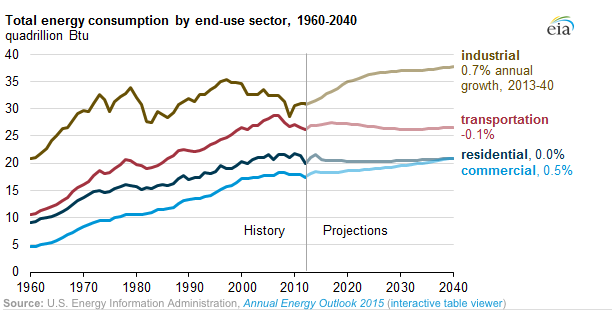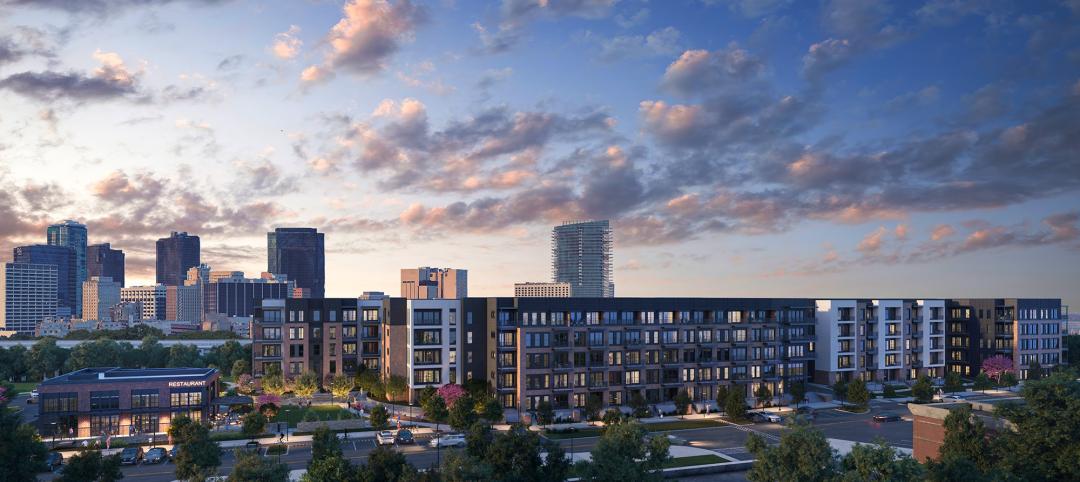Energy consumption in the U.S., which has slowed recently, is projected to inch up by only 0.3% per year through 2040, which would be less than half the projected population growth rate over that period.
In its Annual Energy Outlook 2015, the U.S. Energy Information Administration (EIA) elaborates that industrial energy consumption over the next 25 years will be slightly higher, at 0.7% per year, while annual commercial consumption is expected to be 0.5%.
EIA attributes these consumption reductions to the adoption of energy efficient technologies, as well as “larger structural changes in the economy.” For example, residential consumption has slowed as more people have moved to warmer climates. And policies that have mandated better fuel efficiencies in cars and trucks appear to be having a positive effect.
“These standards, combined with less travel in response to technological and social factors, have reduced transportation energy consumption in recent years and are expected to continue holding transportation consumption nearly flat in the coming decades,” EIA observes.

The department points to several factors that are expected to shape U.S. energy markets in the next generation. These include:
- Growth in U.S. energy production, coupled with only modest increases in domestic demand, will further reduce the country’s reliance on imported energy suppliers. EIA anticipates that energy imports and exports “come into balance” in the U.S. starting in 2028.
- The U.S. will transition from being a modest net importer of natural gas to a net exporter by 2017, with net exports in 2040 ranging from 3 trillion cubic feet (in a low-oil-price scenario) to 13.1 million (in a high oil and gas resource scenario).
- Rising costs for electric power generation, transmission, and distribution, along with slower growth in electricity demand, are expected to lead to an 18% increase in the average retail price of electricity between 2013 and 2040.
- End-user efficiencies are expected to keep energy related carbon dioxide emissions in the U.S. below 2005 levels through 2040.
EIA expects net energy exports to contribute more to the country’s GDP growth than it has in the previous 30 years, partly because of reduced imports. But that impact is also expected to diminish in the later years of this projection cycle, as GDP growth in nations that are U.S. trade partners slows.
Related Stories
Standards | Feb 1, 2024
Prioritizing water quality with the WELL Building Standard
In this edition of Building WELLness, DC WELL Accredited Professionals Hannah Arthur and Alex Kircher highlight an important item of the WELL Building Standard: water.
Industry Research | Jan 23, 2024
Leading economists forecast 4% growth in construction spending for nonresidential buildings in 2024
Spending on nonresidential buildings will see a modest 4% increase in 2024, after increasing by more than 20% last year according to The American Institute of Architects’ latest Consensus Construction Forecast. The pace will slow to just over 1% growth in 2025, a marked difference from the strong performance in 2023.
Construction Costs | Jan 22, 2024
Construction material prices continue to normalize despite ongoing challenges
Gordian’s most recent Quarterly Construction Cost Insights Report for Q4 2023 describes an industry still attempting to recover from the impact of COVID. This was complicated by inflation, weather, and geopolitical factors that resulted in widespread pricing adjustments throughout the construction materials industries.
Hotel Facilities | Jan 22, 2024
U.S. hotel construction is booming, with a record-high 5,964 projects in the pipeline
The hotel construction pipeline hit record project counts at Q4, with the addition of 260 projects and 21,287 rooms over last quarter, according to Lodging Econometrics.
Modular Building | Jan 19, 2024
Virginia is first state to adopt ICC/MBI offsite construction standards
Virginia recently became the first state to adopt International Code Council/Modular Building Institute off-site construction standards.
Mixed-Use | Jan 19, 2024
Trademark secures financing to develop Fort Worth multifamily community
National real estate developer, investor, and operator, Trademark Property Company, has closed on the land and secured the financing for The Vickery, a multifamily-led mixed-use community located on five acres at W. Vickery Boulevard and Hemphill Street overlooking Downtown Fort Worth.
Modular Building | Jan 19, 2024
Building with shipping containers not as eco-friendly as it seems
With millions of shipping containers lying empty at ports around the world, it may seem like repurposing them to construct buildings would be a clear environmental winner. The reality of building with shipping containers is complicated, though, and in many cases isn’t a net-positive for the environment, critics charge, according to a report by NPR's Chloe Veltman.
Sponsored | BD+C University Course | Jan 17, 2024
Waterproofing deep foundations for new construction
This continuing education course, by Walter P Moore's Amos Chan, P.E., BECxP, CxA+BE, covers design considerations for below-grade waterproofing for new construction, the types of below-grade systems available, and specific concerns associated with waterproofing deep foundations.
Sponsored | Performing Arts Centers | Jan 17, 2024
Performance-based facilities for performing arts boost the bottom line
A look at design trends for “budget-wise” performing arts facilities reveals ways in which well-planned and well-built facilities help performers and audiences get the most out of the arts. This continuing education course is worth 1.0 AIA learning unit.
Adaptive Reuse | Jan 12, 2024
Office-to-residential conversions put pressure on curbside management and parking
With many office and commercial buildings being converted to residential use, two important issues—curbside management and parking—are sometimes not given their due attention. Cities need to assess how vehicle storage, bike and bus lanes, and drop-off zones in front of buildings may need to change because of office-to-residential conversions.
















